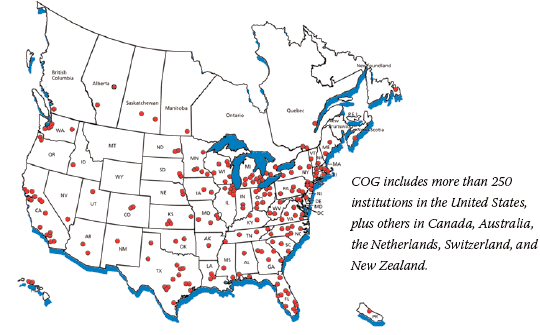 |

Fifty years ago, less than 10 percent of children diagnosed with cancer survived long term. Today, that number is almost 80 percent overall. This radical improvement comes largely from the efforts of the Children's Oncology Group (COG), the nation's largest cooperative clinical research group.
The first U.S. pediatric clinical trials group formed in 1955 and received NCI funding in 1956 to address the difficulty of performing clinical trials for children's cancers. In 2000, this group and other U.S. pediatric trial groups merged to form the COG.

"It was recognized that no individual cancer program or children's hospital had the number of patients that could support clinical investigation by themselves," says Dr. Gregory Reaman, professor of pediatrics at The George Washington University and chair of COG. "Cooperation and collaboration were absolutely necessary."
 |
 |
Pediatric clinical trial
enrollment by eligibility

5 and younger: greater than 90%
10 and younger: 75-90%
10 to 15: 50%
Adolescents aged 15 to 19: 15-25%
|
 |
|
|
The first cooperative clinical trials focused on chemotherapy for acute lymphoblastic leukemia (ALL), the most common childhood cancer. Rapid improvements for ALL through this system led the groups to expand their research to other hematologic cancers, as well as solid tumors, adding surgery, radiation therapy, immunotherapy, and newer targeted treatments to their experimental regimens.
Today more than 40,000 children are treated on or receive followup as part of COG clinical trials at hundreds of hospitals around the world. In the U.S., "the majority of children for whom there are clinical trials, and who are eligible for those trials, are actually enrolled on clinical trials," says Dr. Reaman. This stands in stark contrast to adults, where only a few percent of eligible patients participate in clinical research.
One of COG's main goals is to increase the number of children treated on clinical trials, but they face many of the same barriers to enrollment encountered by researchers working with adult patients, including scarce funding, lack of access for patients in rural areas, and difficulty in some cases getting insurance companies to cover experimental care.
 |
 |
CureSearch - the foundation affiliated with the COG - recently launched a Spanish-language version of its award-winning pediatric cancer Web site at www.curesearch.org/spanish
|
 |
|
|
In addition, explains Dr. Maura O'Leary, administrative officer with COG, for patients who speak English as a second language, the process of informed consent can be complicated. "The ideal would be to print [consent forms] in their own language," she says, so COG has recently started a pilot program to create Spanish-language materials.
In addition to examining the genetics of childhood cancers, COG plans to expand their cancer control, prevention, supportive care, and survivorship research, with international partnerships. "Certain cancers that are rare in the U.S. are more common in other parts of the world, such as Latin America and India," says Dr. O'Leary. "If we can work together to learn how to better treat those cancers, everybody will benefit."
|